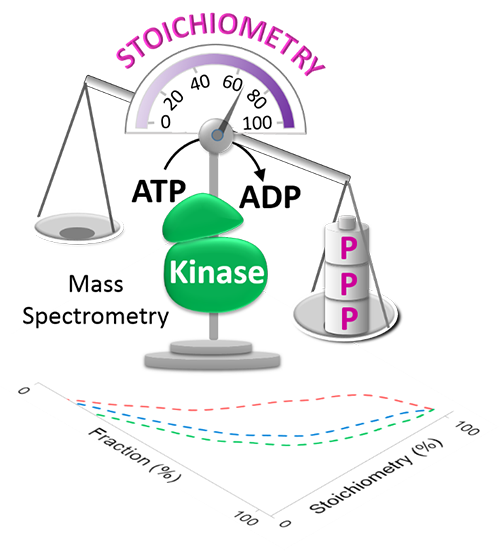Institute of Chemistry, Academia Sinica – Research
以新穎蛋白質體定量平台解析人類細胞的蛋白質磷酸化之計量
Large-scale determination of absolute phosphorylation stoichiometries in human cells by motif-targeting quantitative proteomicsNature Comunications 2015, 6, 6622
Tsai, C.-F.; Wang, Y.-T.; Yen, H.-Y.; Tsou, C.-C.; Ku, W.-C.; Lin, P.-Y.; Chen, H.-Y.; Nesvizhskii, A.; Ishihama, Y.; Chen, Y.-J
蛋白質磷酸化為參與調控細胞功能最關鍵的蛋白質後轉譯修飾之一,藉由定量分析蛋白質體(註:所有蛋白質)之磷酸化修飾有助於解析訊息傳遞網路之全貌。本院化學研究所陳玉如研究員與日本京都大學藥學研究所石濱泰教授所組成的跨國合作研究團隊日前以質譜儀技術為基礎,發展出新穎磷酸化蛋白質體定量技術,此方法首次成功解析出人類細胞在單一狀態下之全體蛋白質磷酸化計量(stoichiometry),並且利用此方法找出和肺癌抗藥性相關的磷酸化蛋白質變異。國際期刊「自然通訊」(Nature Communications)於2015年3月27日刊登這項研究成果。
蛋白質磷酸化的異常調控與疾病產生有極密切的關係,其改變往往主導著驅動與活化整個系統下游的訊息傳遞路徑。因此,透過異常蛋白質磷酸化為新藥開發的重要策略之一。蛋白質磷酸化是藉由磷酸激脢(kinase)及去磷酸脢(phosphatase)所調控,磷酸化計量(stoichiometry) 的定義可視為一個蛋白質中特定胺基酸被磷酸化的比例。蛋白質磷酸化之改變來自兩種途徑,其一源自蛋白質表現量的改變;另一種可能則源自磷酸激脢-去磷酸脢調控所造成磷酸化計量之改變。過去多年來,磷酸化蛋白質體學技術雖已日趨成熟。但現今策略仍然只能測量磷酸化蛋白質相對濃度的改變,完全無法區分所偵測到磷酸化的相對變化是來自於蛋白質含量的改變抑或是磷酸化計量程度上的改變。如何有效地解析整個細胞中磷酸化計量的訊息網路仍然是一大挑戰。
為了克服上述分析挑戰,此團隊結合蛋白激酶反應以及同位素標定定量法,發展了以特定序列為標靶導向的蛋白質體定量平台 (motif-targeting quantitative proteomic approach)。為了驗證此新策略的準確性及靈敏度,此團隊分析了微量的肺癌細胞(50微克),可針對上千條磷酸化胜肽進行磷酸化計量掃描,其中更包含上百條在訊息傳遞上游扮演驅動角色的低含量酪胺酸的磷酸化胜肽。此團隊表示 ”至今,此平台為第一個得以大規模測量人類蛋白質體在常態下磷酸化程度的定量分析平台”。
此外,此團隊應用此蛋白質體定量平台比較對標靶藥物(酪氨酸激酶抑制劑)具有敏感性或抗藥性的肺癌細胞,藉此探討磷酸化計量改變是否與肺癌抗藥機制有關。在具有抗藥性的肺癌細胞中,發現磷酸化計量改變的程度遠高於蛋白質以及基因表現量之差異。經由建立磷酸化計量改變之蛋白激酶與其受質的作用網路,此團隊從中找出和可能調控抗藥性的蛋白質。預期此新穎分析策略未來可以廣泛地應用於解析在不同生理或疾病的磷酸化蛋白質體網路的全貌。
Protein phosphorylation is one of the most critical post-translational modifications to regulate cellular function. Measuring the phosphorylation event at the proteome scale provides a system view for activated signaling pathway. A pioneering study by an international research group which is led by Dr. Yu-Ju Chen from the Institute of Chemistry, Academia Sinica and Prof Yasushi Ishihama from the Graduate School of Pharmaceutical Sciences, Kyoto University has developed a novel mass spectrometry-based technique for the first measurement on the basal level of phosphorylation stoichiometry in a single human phosphoproteome and identified potential molecular changes associated with gefitinib resistance in lung cancer cells. The study was published online on March 27, 2015 in the journal Nature Communications.
Deregulated signaling through protein phosphorylation is intimately linked to pathogenesis of human disease and is one of the most clinically accessed post-translational modifications for developing new therapeutic strategies. The signal-induced alteration in phosphoprotein is regulated either by upstream kinase/phosphatase activity to cause change in phosphorylation stoichiometry, defined as the ratio of the total amount of protein phosphorylated on a specific site to the total amount of protein, or by transcriptional regulation to modify protein abundance. However, traditional quantitative approach can only measure relative quantitation of phosphorylation events without information about the absolute stoichiometry of modification within proteins; direct measurement of phosphorylation stoichiometry, which allows digitizing the cellular signaling network, still remains a challenge by existing approaches.
To overcome the current bottleneck in accessing the stoichiometry of single-state human phosphoproteomes, we have developed a motif-targeting quantitative proteomic approach by integrating enzymatic kinase reaction and isotope-based quantitative proteomic strategy. The quantitation accuracy and sensitivity of this approach was demonstrated on the proof-of-concept experiments in lung cancer cell; phosphorylation stoichiometry of >1000 phosphorylation sites including 366 low abundant tyrosine phosphorylation sites were successfully measured with high reproducibility. To our knowledge, this approach reveals the first large-scale measurement on the basal level of phosphorylation stoichiometry in a single state human phosphoproteome.
This research group further applied this developed motif targeting quantitative approach for phosphorylation stoichiometry profiling of drug resistance/sensitive lung cancer cells. On the comparison of TKI (tyrosine kinase inhibitor) sensitive (PC9) and resistance lung cancer cell (PC9/gef.), the quantitative information not only illuminated that the post-translational phosphorylation changes are significantly more dramatic than those at protein as well as mRNA levels, but also suggested potential drug-targeting proteins in the kinase-substrate network associated with acquired drug-resistance. We expected that this newly developed approach will have wide applications to provide system-wide maps of protein phosphorylation stoichiometry for either single or multiple cellular states under physiological or pathological regulation.
The complete article is available at the Nature Communications journal website at:
Nature Communications.
The complete list of authors is: Chia-Feng Tsai, Yi-Ting Wang, Hsin-Yung Yen, Chih-Chiang Tsou, Wei-Chi Ku, Pei-Yi Lin, Hsuan-Yu Chen, Alexey I. Nesvizhskii, Yasushi Ishihama and Yu-Ju Chen
Media contacts:
Dr. Yu-Ju Chen, Research Fellow, Institute of Chemistry, Academia Sinica, yujuchen@gate.sinica.edu.tw (Tel) +886-2-2789-8660

